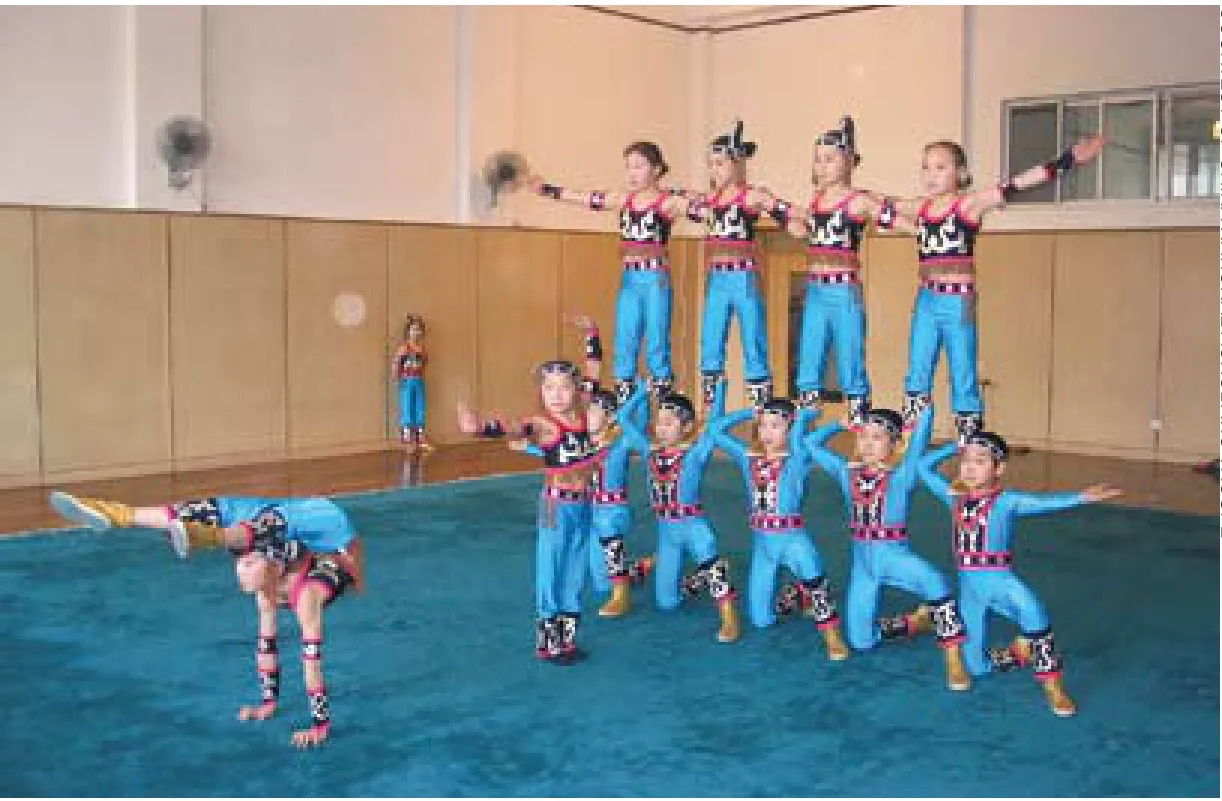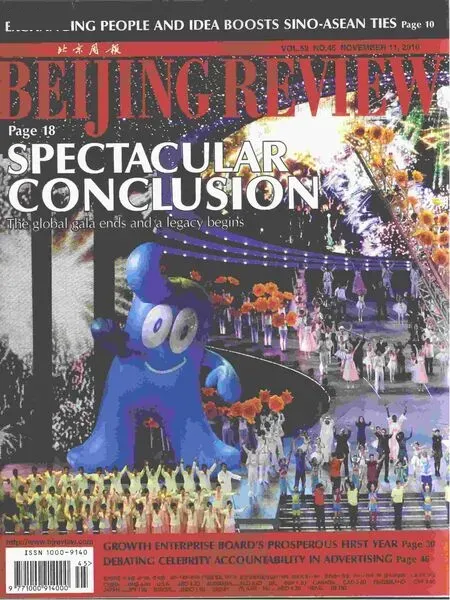A Jubilee Letter In Acrobatics
2010-10-14ByTANGYUANKAI
By TANG YUANKAI
A Jubilee Letter In Acrobatics
By TANG YUANKAI
An acrobatic school restores the legend of the traditional Chinese art
O ctober 20 this year marked the 60th anniversary of the China National Acrobatic Troupe (CNAT). The grand performance,A Family Letter, was held at the Great Hall of the People on October 19 and 20 to celebrate the occasion. The performance, a spectacular award-winning show, depicted the letter of a young acrobatic student to his mother, telling the story of how the nameless acrobatic trainee grew up to be an outstanding artist.
The director He Xiaobin said through the celebrative performance the art troupe hopes to express its gratitude to society’s support in the past 60 years.
Tradition
Chinese acrobatics has been in existence for nearly 3,000 years because of the tradition of passing feats from a master to students continuing to challenge performers’ limits. In this tradition, students greatly respect their masters, and try their best to preserve and to do everything possible to pass the traditions down.
Before the founding of the People’s Republic in 1949, the acrobatic arts were inherited in a way of oral instruction among family members, as well as between masters and students. When teaching acrobatic skills, the virtues of the older-generation artists were also passed to their successors.
On September 10, 1954, CNAT enrolled its frst students. Since then, the tradition of family teaching model has been replaced by a new training form.
CNAT invited its outstanding acrobats and dance experts from the former Soviet Union to give specialized training for more than 30 students from all around the country.
CNAT also sent excellent acrobats to other places in the country, helping local acrobatic circle improve their training and giving them strong support in the aspects of scripting, costumes, props and music.
“In the past, traditional Chinese acrobats had great limitations in teaching methods. The feats of an apprentice depended on and were limited to his master’s skills. Besides this, because of the lack of scientifc teaching methods, the old way of training sometimes went against young acrobats’development of skill,” said Li Yannian, an expert on acrobatics.
The efforts to modernize the acrobat training system have brought about several schools for this purpose across China.
In 1999, the Beijing International Arts School (BIAS) was set up, the frst school of acrobatics in Beijing, also the frst school to specialize in training acrobatic talents.
Dedication
In 1995, 45-year-old acrobat Sun Lili, who was a popular star of acrobatics at that time, was given a new task: teaching at the newly founded Acrobatic Circus Department of the Beijing Art School (predecessor of BIAS). But that meant she had to give up performing on stage since then.
Sun’s 60 or so students were from 5 to 10 years old. It was really a great challenge for Sun to teach the children. At frst, almost all of them could not bear the hard training and missed their homes. Sun gave them rigorous training in basic skills while providing encouragement.
Basic skill training can be boring, especially for those at this age level. But, generally speaking, basic skills should be inculcated at a young age, or the opportunity may be lost for training to be the best, said Sun.
“Acrobatics is a kind of art. Acrobatic training requires efforts beyond the ordinary,”Sun tells her students. “Art itself is linked to bitterness and diffculty. You can’t enjoy the pleasure of art without hard training.”
Her students later understand her and fondly call her “Mother Sun.” In her eyes,“daring to endure hardship” is a fundamental quality of an acrobat.
Di Hui, now 21, is one of the principal CNAT acrobats and has been successful because of her love to the art and strong willpower in training.
When Di came to Beijing from her hometown Harbin to audition 10 years ago, she was almost refused by Sun because of her age—she was a little bit older than the required age. But Di’s indomitable spirit and dedication to acrobatics fnally moved all the teachers and gained her an opportunity for a three-month probation.
Di was assigned to an experienced teacher, Zhou Yuexiang, to learn the art of contortion, an unusual form of physical display involving the dramatic bending and flexing of one’s body. But Di, at that time, had missed the best period for training of body flexibility for contortion. That meant she had to put out greater efforts and endure more hardship in training.
Eventually, Di successfully survived the probation and went on to study at the school. Her story also confrms if an acrobat wants to be successful, the effort made is more important than advantages of congenital physical condition.
Relying on strong willpower and hard training, together with an excellent programTwo People Spinning the Mugsdesigned for her, Di won the highest award in an international circus festival on January 10, 2004.
Besides Di, other students in the school also wowed world audiences by their marvelous feats. The performanceSlack Wireby BIAS students won the highest award at the 24th Tomorrow Circus Festival, the Republic of France’s President Award in France in January 2003.
In recent years, BIAS has trained a large number of outstanding acrobatic talents. Many leading artists of CNAT are graduates from BIAS. Acrobatic students from the school even won dozens of gold medals in major competitions at home and abroad during their internship in CNAT.
In order to make audiences laugh more, besides applauding and screaming for the stunning performances, last year, BIAS set up China’s frst burlesque performing major, another pioneering work of the school following the publication of a series of textbooks on acrobatics.
“Whether the art of acrobatics develops or not is mainly related to the importance attached to skill training, student selection and good teachers, as well as excellent teaching materials,” Li said, “we need a scientifc education method.”
Internationalization
BIAS was also the first Chinese acrobatics school enrolling foreign students. At present, there are nearly 50 overseas students from 11 foreign countries studying Chinese acrobatics, of which the youngest one is only 7 years old, while the oldest is nearly 30. Most of the overseas students are attracted by the fame of BIAS and CNAT.
“I like Chinese acrobatics. After fnishing my study, I can perform everywhere all around the world following acrobatic troupes, which will also help me understand the world better,” a young student from Russia said confdently. He is optimistic about his future job prospects; in the meantime, he knows he should train hard.

BIAS has set different teaching plans and set different training programs for overseas students, based on their physical conditions, the period they study in the school, majors and specifc requirements.
“The happiest thing for me is to see my students doing well in performance and competitions,” said Liu Baoxiang, who teaches foreign students at BIAS. “I am together with them every day, and they are like my children.”
In 2006, he taught several students from Myanmar. Most of them had no basic acrobatic skills. “After several years of study and training, they are good enough to perform on stage.”
In October 1997, a group of Russian students without any basic acrobatic training arrived at BIAS to study the Chinese art form. After seven years, they graduated. In their graduation performance, they skillfully performed 10 kinds of traditional Chinese acrobatics, such as pole climbing. They also put on performances that won international awards when they studied in China. After returning to Russia, they became star acrobats in a Russian circus.

COURTESY OF ChINA NATIONAL ACROBATIC TROUPE

COURTESY OF ChINA NATIONAL ACROBATIC TROUPE
A LETTER TO HOME: Acrobats show their feats at grand performance on October 20 to celebrate the 60th birthday of the China National Acrobatic Troupe
